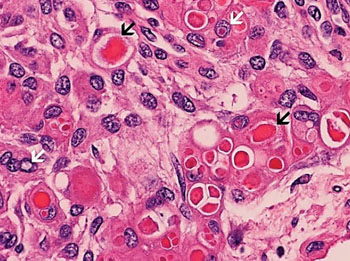Molecular Signature Identified for Aggressive Brain Tumor
By LabMedica International staff writers
Posted on 23 Nov 2016
Meningiomas are the most common primary brain tumors, but the term encompasses over a dozen subtypes that range from benign to highly aggressive. Rhabdoid meningiomas are classified as highly aggressive due to their high rates of recurrence and mortality, but the experience and outcomes for patients with this rare form of brain tumor vary widely.Posted on 23 Nov 2016
A routine test can be used to identify which patients may require intensive clinical management and surveillance for aggressive brain tumors as genetic mutations have been identified in this form of brain cancer that can distinguish aggressive rhabdoid meningiomas from more benign forms using routine laboratory tests. The new findings could have immediate implications for clinical decision-making.

Image: A histopathology of rhabdoid meningiomas characterized by enlarged epithelioid cells with large nuclei and prominent nucleoli. Bright intracellular secretions (black arrows) are present. Note that the sizes of these vacuoles are several times the size of the nuclei. Intranuclear pseudoinclusions are also present (white arrows) (Photo courtesy of Kar-Ming Fung, MD, PhD).
A large team of scientists in collaboration with Brigham and Women's Hospital (Boston, MA, USA) defined genomic aberrations of rhabdoid meningiomas, by performed sequencing of cancer-related genes in 27 meningiomas from 18 patients with rhabdoid features and evaluated breast cancer [BRCA]1–associated protein 1 (BAP1) expression by immunohistochemistry in 336 meningiomas. They assessed outcomes, germline status, and family history in patients with BAP1-negative rhabdoid meningiomas.
The team went on to analyze samples from 47 patients with rhabdoid meningiomas as well as 265 additional meningiomas of diverse subtypes and grades. None of the non-rhabdoid meningiomas had a loss of BAP1. However, five of the 47 patients with rhabdoid meningiomas did have mutations or deletions affecting BAP1. These patients had poor clinical outcomes: two died of the disease and two had multiple cases of recurrence; clinical follow-up information was not available for the fifth. For those patients with intact BAP1, average time of disease progression was 116 months; for the patients with BAP1 mutations, it was only 26 months.
Sandro Santagata, MD, PhD, a pathologist and a senior author of the study, said, “Testing for BAP1 in rhabdoid meningiomas could be performed routinely and at a low cost, with the potential to change the course of clinical care and avoid overtreatment or to identify those who may need more aggressive therapy. We hope that this new work will offer insights for clinicians and patients alike as they seek more information on these tumors.” The study was published on November 10, 2016, in the journal Neuro-Oncology.
Related Links:
Brigham and Women's Hospital




 assay.jpg)









